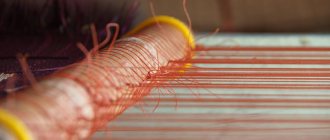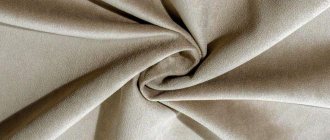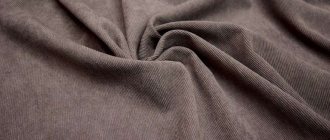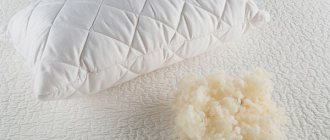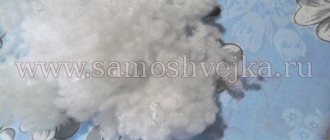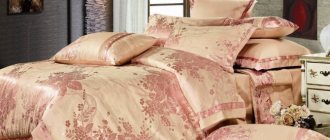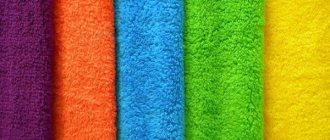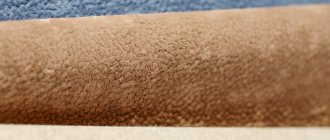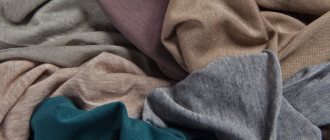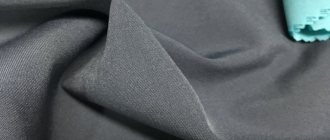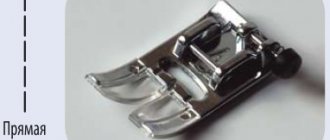Many new generation synthetic materials quickly gained popularity due to their unique consumer properties. Thus, acrylic fiber, which appeared in the middle of the twentieth century, is still one of the best synthetic materials. It is valued for its durability, pleasant texture, and beautiful appearance. Let's take a closer look: how acrylic is obtained, what kind of fabric it is, what are its characteristics, pros and cons, is it a natural fabric/material or not, does acrylic shrink after washing or not, does it keep you warm in winter.
History of creation
Acrylic dates back to the forties of the twentieth century, when American specialists began developing a new fabric based on hydrocyanic acid and acetylene. It had to compete with wool. In 1948, such material was obtained. Orlon had a big drawback - it was difficult to paint. Work to improve the technological process continued, and in 1952, the goal was achieved. For the first time, a material with a smooth texture and a clear and bright pattern was presented to the public. It was called "acrylic". When dyeing it, a special technology was used, which made the colors extremely durable. Coloring took place at the production stage, while the acrylic was in a liquid state. As a result, the threads turned out to be bright and evenly dyed.
Acrylic gradually gained popularity and became a full-fledged and independent fabric. Consumers appreciated it for its high strength, wear resistance, and easy maintenance. The improvement of the fabric continued, work was carried out to eliminate the shortcomings: tendency to wear out, irritating effect on the skin. Several varieties of acrylic were produced. Today they are known under the names: redon, nitron, PAN fiber, polyacrylonitrile.
Modern acrylic material, according to many consumers, is superior to wool. In a number of indicators it can compete with cashmere. It is valued for its softness, ease of care and durability.
Acrylic, what kind of fabric is it, is it synthetic or natural material?
The word “acrylic” is of English origin, translated into Russian it means “acrylic resin”, it is pleasant to the touch and has a beautiful appearance. It has retained all the advantages of natural fabric, its softness and warmth and, at the same time, acquired clearer colors, is durable, and does not deform. Due to its resemblance to woolen fabric, acrylic was called “artificial wool”. Today, warm clothes are knitted from acrylic fiber, but this is not the only use of the fabric. You can find embroidered products; the material is used for upholstering upholstered furniture, making rugs and bedspreads, awnings and tents.
What is acrylic made from? Acrylic production technology is quite complex. It is based on the breakdown of the toxic gaseous substance acrylonitride by polymerizing it under the influence of high temperatures and pressure. During the polymerization process, the starting substance turns into a liquid state. The resulting solution is squeezed through special equipment into air or water. After hardening, the resulting fibers are washed, cut and dried, and then rolled into a ball. If the goal is to obtain a material with special properties, then natural fibers are added to liquid acrylic at the production stage, obtaining mixed compositions.
Acrylic represents a group of polyamide fabrics. In addition to it, this group includes nylon, bologna, lacquer, perlon, nylon. All of them are highly durable. They are non-hygroscopic, but absorb fats well, are easy to wash, and dry quickly.
Advantages
Acrylic is a synthetic material, so it is not necessary to store such an item in the anti-moth department. The insulated item made from this material itself is quite unpretentious and wear-resistant during operation.
This material has a number of advantages over many other fabrics:
- the softness and delicacy of acrylic makes this item pleasant to the body , providing comfort while wearing;
- durability of the material provided it is properly cared for;
- the item does not wrinkle or pill as much as natural fibers;
- acrylic fabric dries quickly enough even in a cool room;
- Colored items made from this material look especially impressive , since acrylic stains very well and retains its brightness and color saturation for a long time;
- affordability.
Description and characteristics
Acrylic is a synthetic fabric produced from the chemical transformation of natural gas compounds. The material is completely safe for people. Thanks to its excellent consumer properties, it has a wide range of applications.
Acrylic fibers have a smooth texture. When creating fabrics, various thread weaving techniques are used:
- plain weave (the simplest);
- knitted (based on weaving loops);
- matting (with a pronounced thread pattern);
- jacquard (weaving threads according to a specific pattern).
Canvases can be plain or printed, decorated with a printed design or pattern. Acrylic is used to create elegant and warm winter products that are not inferior in quality to woolen items.
Acrylic fabric: pros and cons
The main advantages of acrylic include the following:
- soft texture;
- thanks to thick multi-layer threads, acrylic items are very warm;
- fabrics retain their shape well;
- after washing, the products dry quickly without losing their shape;
- the fabric is durable, which means a long service life;
- modern acrylic is completely safe for people prone to allergies;
- material made from inorganic raw materials is not susceptible to damage by insects;
- acrylic is more hygienic compared to natural fabrics;
- acrylic products are cheaper.
The biggest advantage of acrylic fabric is the possibility of durable and uniform coloring of things, and the colors on clothes do not fade throughout their entire service life.
Like any synthetic fabric, acrylic has its disadvantages:
- Air tightness. Large knitting partially solves this problem.
- Acrylic fabric has the property of accumulating static electricity. This problem can be solved by using antistatic sprays.
- With improper care (use of harsh detergents, drying on heat sources), acrylic products may lose their softness.
- When worn for a long time, acrylic fabric tends to pill.
Careful care of acrylic items reduces the negative properties of acrylic fabrics. A fabric that is a mixture of natural ingredients and acrylic will completely eliminate these shortcomings. Blended compositions have the hygroscopicity of wool or cotton and, at the same time, boast the brightness of colors inherent in acrylic.
Acrylic items
Today, many people prefer acrylic, which is widely used for making various clothes and sleeping sets. This material is not expensive and easy to use; it is used almost everywhere, including sewing underwear from acrylic. And even world-famous manufacturers use acrylic in a composite with fibers from natural raw materials. Clothing stores offer a large number of acrylic blouses and dresses. Is it worth purchasing them, and how long can they last while maintaining their original appearance?
What's good about acrylic?
Many people know that acrylic is an artificial material. And despite this, it has properties that make its use relevant. Many mothers cannot afford to buy their children things made from cashmere or other soft natural fibers, which are quite expensive.
And then they choose things made from “artificial wool” - acrylic, which is affordable, soft for the baby’s delicate skin, and does not cause allergic reactions or irritation. Many children simply do not want to wear woolen clothes, citing the fact that they are pricked and pinched.
Items made of acrylic, provided that the fibers are of high quality, almost do not shrink or stretch during washing. This material is universal, withstanding multiple heat treatments, good wearability and durability, and pleasant to the touch. Many consider clothes made from synthetic fibers to be the most practical, maintaining a decent appearance for a long time. They dry quickly after washing and practically do not need ironing.
The existing prejudice that the body practically does not breathe in synthetic clothing is somewhat outdated today. After all, new generation fabrics can “boast” of a soft texture, pleasant texture, and partially allow air to pass through. They are resistant to fading and fading.
Acrylic is often used in the form of knitting yarn. Products made from acrylic thread do not “fall off” so much, are comfortable to wear and warm. In knitting yarns, it is often found mixed with mohair or wool, which adds fluffiness and heat resistance to the finished product.
The positive thing is that things made from “artificial wool” will not be a “delicacy” for moths, which cannot be said about wool or other natural products.
Disadvantages of things made of acrylic
This type of clothing has its drawbacks:
- low hygroscopicity, which affects hygienic qualities,
- acrylic items become electrified, slightly “creak” to the touch and roll off over time,
- when it’s warm outside, it’s hot in acrylic clothes, and when it’s cold, it’s not warm enough.
If the acrylic is of low quality, then the item made from it can stretch after washing, becoming less durable and less wearable, and lasts much less.
Bed linen made from this fabric wrinkles a lot, which is not good. It is not hygienic; various harmful bacteria and fungi can multiply.
Caring for acrylic clothing
If you want your acrylic clothes to last longer and look good, follow certain rules for their maintenance. Wash by hand, use a variety of detergents, but do not contain bleach.
When washing, use water at room temperature, and add an antistatic agent when rinsing. Never twist acrylic items after washing. Better yet, wrap them in a large terry towel and gently wring them out.
Dry such items on a horizontal surface, carefully spreading them out.
Ironing should only be done with a low-heat iron using a damp cloth. Many people do not recommend steaming acrylic items.
Whether or not to buy things made of acrylic, everyone must decide for themselves, according to their capabilities and needs. Many people prefer mixed materials that simultaneously contain natural and artificial fibers, thereby combining the practicality of synthetics and the environmental properties of fabrics made from natural fibers.
Video
Compound
Nowadays, mixed fabrics that have the advantages of all the materials included in its composition are more often used.
There are synthetic additives such as polyester, polyurethane and vinyl. They further increase the strength of the original material, while simultaneously imparting water-repellent properties, which is ideal for outerwear.
But fabrics with natural additives are especially valued. Items made of acrylic with the addition of wool are very warm, fluffy, hygroscopic, and do not electrify. But at the same time, they have durable colors, hold their shape well and do not shrink. Fabrics made from acrylic with cotton do not wrinkle, absorb sweat well, and wash well. The viscose additive gives the fabrics a special silky structure .
- Polyacrylic (5% admixture and 95% acrylic). Cotton, wool, and angora can be used as admixtures. This mixture composition is very popular.
- Modacrylic or modified fabric (includes vinyl and acrylic in varying ratios). This material is very durable, does not rub off or tear. Awnings and curtains are made from it.
- Acrylic and mohair. The combined composition, the percentage of components may be different. The resulting mixed material has excellent thermal characteristics: very warm, durable, bright.
- Microacrylic or acrylic yarn is a synthetic knit fabric created from finer threads on knitting machines.
The use of artificial and natural additives makes acrylic a universal material that can be used in any situation.
Flaws
However, in addition to the positive properties, an item made of synthetic fibers also has several disadvantages that you must pay attention to before purchasing such an item:
- unnaturalness of the material , which makes the item not as warm as natural wool yarn;
- being a synthetic product, such an item can be hot in sunny weather , since the fabric does not allow air to pass through very well;
- such material is highly electrified and magnetized;
- It is quite problematic and difficult to remove greasy and oil stains from the surface of a product made from this material , which immediately pass inside and are absorbed deep into the fabric.
Most often, this material is supplemented with natural fibers to reduce negative qualities and make the item warmer and more pleasant to wear.
Usually wool, cotton or mohair are added to acrylic. The percentage of acrylic material varies from 30 to 50-70%.
Scope of use
Thanks to the developed technologies for modifying acrylic fabric, its scope has become even wider. It successfully combines ideal wearing qualities (softness, warmth, shape retention) and practicality (strength, wear resistance, low price).
This fabric is used as a material for sewing clothes and knitting warm clothes. It makes excellent sportswear, workwear, and equipment for sports expeditions. It behaves well as a base or lining material.
100% acrylic yarn is used for sewing clothes: sweaters, jumpers, hats, scarves.
In stores you can find acrylic yarn of the most incredible shades, intended for needlework. It makes great winter sweaters. They are light, warm, fluffy, retain their shape and do not shrink.
High density acrylic fabric can be used as textile material. It is used for upholstery of upholstered furniture, sewing blankets, capes and bedspreads. Soft acrylic toys have hypoallergenic properties and are safe for small children.
The material is widely used for sewing curtains. They are durable, have excellent decorative properties, do not fade, and successfully drape the space.
And one more, perhaps the most unusual area of application of acrylic is outdoor advertising. Often, acrylic canvases are used to prepare all kinds of visual advertising elements - banners, banners and signs. They are light, durable, do not fade for a long time and do not tear.
Does an acrylic hat keep you warm?
Very important – acrylic and acrylic are different. It also differs in cost. You can even tell the difference by touch. Inexpensive - it will squeak under your fingers, it is rough, stuffy, you can immediately see that it is synthetic. Much higher quality - quite soft, pleasant to the skin, lightweight and quite difficult to distinguish by appearance from foreign cotton or blended yarn.
Characteristics of acrylic, hygroscopicity
Acrylic is a synthetic fiber derived from petroleum, an organic product. It is a very good replacement for wool. Properties:
- Keeps its shape.
- It paints well, so the choice of colors is quite wide.
- Excellent heat transfer.
- Very high wear resistance. An acrylic hat withstands constant washing and will serve for years without losing its appearance. If the material is of high quality, it does not peel.
- Low hygroscopicity, due to which things breathe poorly.
About hygroscopicity in more detail
This indicator affects the hygienic properties of matter and the regulation of heat between human skin and the external environment. Heat transfer in this embodiment is a diverse phenomenon that consists of most physical and biological processes. This can be heat conduction, convection, moisture vapor conduction, radiation.
Things made from natural materials, especially wool, have a structure that takes into account multiple ways of heat loss, which is why they protect very well from the cold. Nature took care of this. Wool absorbs remaining moisture, warms in the cold and breathes in the heat.
INTERESTING. The hygroscopicity of wool under normal conditions is 15-17%; in conditions of very high humidity, the same wool can absorb up to 40%, and in both cases it will remain dry to the touch.
Acrylic has low and constant hygroscopicity, thanks to which things made from it become very heavy when wet, but dry in a short time. And thanks to this, acrylic is cooler than wool. It blocks the escape of heat, but does not create a layer of air between the human body and the environment. It does not adapt to air humidity and will not absorb remaining moisture. Evaporating moisture from the skin acts as a cooling agent. If there is no excess moisture in the air or on the skin, the thing will actually seem very warm and soft, since it reliably retains its dry heat from the human body.
What to wear with jockey boots: style tips for different seasons
Is this hat warm?
Whether an acrylic hat will keep you warm depends on the weight of the indicators. The quality of the material itself, the density of the knitting, the folding of the threads, the owner’s own “frost resistance”, the quality of the cold (wet cold or dry, is there any wind). Reviews from real consumers contain various information: from “it’s hot in the heat, cool in the cold” to “it was warm even at -30°C.” Acrylic hats should definitely not be recommended for people who sweat a lot. All others will be able to choose a very warm headdress in the segment of things made from this material. When in doubt, it is wiser to choose a hat made from a blended yarn. High-quality versions of such yarns combine the good properties of acrylic and natural fibers well. They are warm, lightweight, wear-resistant, affordable and painted in stylish colors.
Care
Acrylic fabric is very unpretentious, but without proper care the service life of things is significantly reduced. High temperatures, wet twisting, and washing in harsh detergents have a detrimental effect on the material.
How to wash acrylic items? Things are washed at moderate water temperatures, using a mild detergent with the addition of conditioner. When finished, rinse them thoroughly, then, without squeezing, allow the water to drain and lay them out to dry in the open air. When machine washing, set the regulator to the appropriate mode.
If there is a greasy stain on the product, chlorine-containing bleach is used to remove it. The solution is carefully applied to the stain and left for a while. Then rub with a soft bristle brush until the stain disappears and rinse thoroughly.
Ironing of products is not recommended. If necessary, set the iron to the “synthetic” setting and carefully iron it through a damp cloth.
Use in other areas
Polymers based on acrylic acid are also used in other areas, for example, in construction and the production of household items. This is how various types of plexiglass appeared based on etrusion (produced by pressing) and cast (produced by pouring) acrylic. Acrylic sheets are highly durable and have a smooth surface, which makes it possible to make high-quality bathtubs from them. Polymer-based paints are used for painting glass, wood and other non-greasy surfaces.
